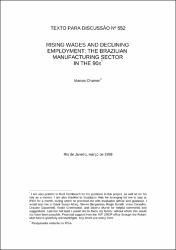Please use this identifier to cite or link to this item:
https://repositorio.ipea.gov.br/handle/11058/2039Full metadata record
| DC Field | Value | Language |
|---|---|---|
| dc.contributor.author | Chamon, Marcos | - |
| dc.contributor.other | Dornbusch, Rudi (Colaborador) | - |
| dc.contributor.other | Reis, Eustáquio (Colaborador) | - |
| dc.contributor.other | Athey, Susan (Colaborador) | - |
| dc.contributor.other | Bergantino, Steven (Colaborador) | - |
| dc.contributor.other | Bonelli, Regis (Colaborador) | - |
| dc.contributor.other | Carvalho, Irineu (Colaborador) | - |
| dc.contributor.other | Giacomelli, Drausio (Colaborador) | - |
| dc.contributor.other | Greenwood, Robin (Colaborador) | - |
| dc.contributor.other | Muriel, Beatriz (Colaborador) | - |
| dc.coverage.spatial | Brasil | pt_BR |
| dc.coverage.temporal | 1985-1996 | pt_BR |
| dc.date.accessioned | 2013-10-31T16:41:08Z | - |
| dc.date.available | 2013-10-31T16:41:08Z | - |
| dc.date.issued | 1998-03 | - |
| dc.identifier.uri | http://repositorio.ipea.gov.br/handle/11058/2039 | - |
| dc.description.abstract | Trata da questão da produtividade, aumento de salários e emprego no setor industrial nos anos 90, bem como, da substituição de trabalho por capital e o declínio do emprego industrial. | pt_BR |
| dc.language.iso | en-US | pt_BR |
| dc.publisher | Instituto de Pesquisa Econômica Aplicada (Ipea) | pt_BR |
| dc.title | Rising wages and declining employment: the Brazilian manufacturing sector in the 90's | pt_BR |
| dc.title.alternative | Texto para Discussão (TD) 552: Rising wages and declining employment: the Brazilian manufacturing sector in the 90's | pt_BR |
| dc.title.alternative | O aumento dos salários e redução do emprego: o setor industrial brasileiro na década de 90 | pt_BR |
| dc.type | Texto para Discussão (TD) | pt_BR |
| dc.rights.holder | Instituto de Pesquisa Econômica Aplicada (Ipea) | pt_BR |
| dc.source.urlsource | http://www.ipea.gov.br | pt_BR |
| dc.location.country | BR | pt_BR |
| dc.description.physical | 19 p. : il. | pt_BR |
| dc.rights.license | É permitida a reprodução deste texto, desde que obrigatoriamente citada a fonte. Reproduções para fins comerciais são rigorosamente proibidas. | pt_BR |
| dc.subject.keyword | Aumento de salários | pt_BR |
| dc.subject.keyword | Emprego no setor industrial | pt_BR |
| dc.subject.keyword | Declínio do emprego industrial | pt_BR |
| ipea.description.additionalinformation | Referências Bibliográficas: possui referências bibliográficas | pt_BR |
| ipea.description.additionalinformation | Série Monográfica: Texto para Discussão ; 552 | pt_BR |
| ipea.access.type | Acesso Aberto | pt_BR |
| ipea.rights.type | Licença Comum | pt_BR |
| ipea.englishdescription.abstract | The 90s have been quite an eventful decade in Brazilian macroeconomics. There have been recessions, recoveries, hyperinflation, trade liberalization, many failed stabilization attempts, a successful one, exchange-rate overvaluation, just to name a few. Despite all these, since the beginning of this decade there has existed a strong trend for rising wages and declining employment in the manufacturing sector, which is somewhat surprising since historically employment and wages have moved together. The very same period is marked by an astonishing productivity growth in manufacturing that can do much to explain how employment and wages behaved the way they did. This paper explores this productivity issue, making some conjectures as to its origins and how it can shed light into this problem. This paper will also address the issue of substitution of labor by capital, and to which extent it can account for the decline in manufacturing employment. While data availability prevents us from obtaining a good estimate of the substitution between labor and capital, it is still possible to obtain rough measures of the cross-price elasticity of labor and capital. With those estimates and data on relative input price changes it is possible to assess the role of factor substitution in the observed decline in employment. | pt_BR |
| ipea.researchfields | N/A | pt_BR |
| ipea.classification | Emprego. Trabalho | pt_BR |
| ipea.classification | Indústria | pt_BR |
| Appears in Collections: | Emprego. Trabalho: Livros Indústria: Livros | |
Files in This Item:
| File | Description | Size | Format | |
|---|---|---|---|---|
| td_0552.pdf | 108.99 kB | Adobe PDF |  View/Open |
Items in DSpace are protected by copyright, with all rights reserved, unless otherwise indicated.

